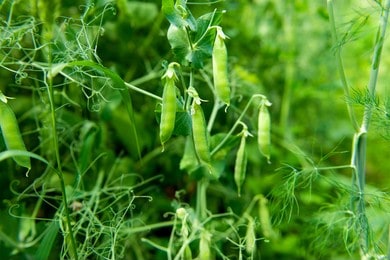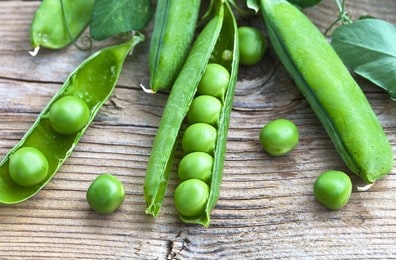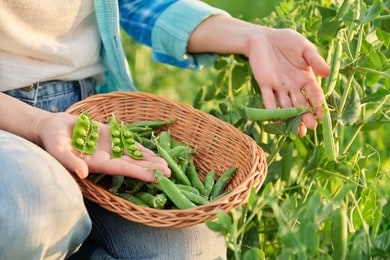So you think the peas you’ve been growing in your yard are ready to be picked? Nothing compares to the flavour of a sweet, young, tender pea that has just been popped from its freshly harvested pod, and the only way to get that sensation is to grow your own.
When it comes to plucking ‘regular’ peas, you’ll know they’re ripe about three weeks after the blooms appear. Feel the pods gently; the peas should be beautiful and plump. But don’t overcook the peas; they’ll become starchy and tough if you do. When the mange tout and sugar snap pods are about 7cm long, pick them. Select your way up the plant, starting at the bottom and working your way up; the more you pick, the more the plant will produce.

Table of Contents
Introduction to Growing Peas
Many of you, I’m sure, have already started the pea-growing process. My buddy, for example, routinely sows her peas in small lengths of plastic guttering with drainage holes drilled in them, a technique pioneered by the late, great Geoff Hamilton.
My friend plants the pea seeds about 8cm apart and 3cm deep in a general-purpose compost and keeps the whole thing in her cold greenhouse, watering as needed, until the soil outside has warmed up and the seedlings are large enough to go out. Of course, she hardens them first before dumping the full contents of the gutters into small holes she’s already dug.
When It’s Warmer Outside
Now that the soil has warmed up (it’s June 2022 at the time of writing), you may sow your seeds directly into the ground and rest assured that they will grow quickly.
Rather than planting single rows, dig a shallow trench large enough to accommodate two rows and alternately space the seeds, keeping them about 8cm apart. They’ll soon be well on their way to colonising the supports you’ve supplied for their tendrils to wrap around.
Providing Nutrition for Your Peas
Peas require an open sunny spot that is sheltered from the wind, as well as good, healthy soil, whether they are started under cover or planted directly into the soil. Watering is also crucial. Keep them well-watered throughout the flowering process and until you’re ready to harvest. The pods will not mature properly if they dry out.
Pests and Diseases of Peas
When producing your own peas, pests and diseases may be a nightmare, so here are a few to be wary of:
Cydia Nigricana is a species of Cydia Nigricana.
The pea moth’s caterpillar (Cydia nigricana) will contentedly nibble on your peas within the pod without your knowledge — until you open it up, that is.
Because the female moth is drawn to flowering pea plants, the only surefire way to keep her from getting to them in the first place is to grow your peas in insect-proof mesh. Other insects, such as bees, will be excluded by definition, but because pea pods are self-pollinating, this will have no negative impact on the crop.
Mice
Mice will be drawn to the seeds, therefore traps may be necessary to protect your prized seeds.
Aphids
These small sap-sucking insects can quickly grow in numbers, especially if the weather is warm and dry. They can cause the plant to become stunted, with little, deformed peas as a result. You can typically just wash them away with a hose or try planting some aphid-repellent plants nearby.
Pigeons
Pigeons, the misery of many a gardener, are attracted to pea plants and will strip them down to the stalks in the blink of an eye. Netting, like the moth mesh, is the only foolproof technique to keep your peas safe.
Mildew Powder
Powdery mildew is a fungal disease that can harm peas but is not a pest. The easiest approach to avoid this is to keep the ground moist at all times (drought-stressed plants are more sensitive to powdery mildew) and to not plant too close together.
Variety of Peas

Varieties? What you want to grow will determine a lot. Do you want to plant ‘regular’ peas in pods, like the ones I mentioned at the start of this essay, or do you want to produce mange tout or sugar snap peas, which you eat whole, pod and all?
If you’re sowing peas for the first time, ‘Balmoral,’ ‘Dorian,’ or ‘Kelvedon Wonder’ are good choices. Petit pois cultivars such as ‘Peawee’ and ‘Petit Provencal’ produce little, extremely sweet peas.
Try ‘Oregon Sugar Pod’ or ‘Reuzensuiker’ for mange tout, where the peas aren’t allowed to mature at all. Sugar snap peas are where the peas grow, but you can eat the pod as well: try kinds like ‘Sugar Ann’ or ‘Cascadia.’
You might even want to grow peas just for the shoots, but I’d advocate taking a completely opposite approach: treat them like’micro-greens,’ just allowing the plant to develop a set of tendrils before cutting them. As a kid, do you recall cultivating cress in the kitchen or using blotting paper? That is the concept.
Following the Harvest
Cut the top growth off at ground level and add it to the compost bin once you’ve harvested all of your peas and the plants are spent. However, instead of digging up the roots, slice them up and turn them into the soil. The plants have taken nitrogen from the air and ‘fixed’ it in their roots, which will eventually be released into the soil, giving an important natural nitrogen source.
Conclusion
Hopefully, you now know when and how to select peas as well as how to grow your own. So, to summarise:
- 3 weeks after the blossoms have bloomed, pick your peas.
- Look for good, plump peas in the pods.
- Allowing your peas to grow too large will make them rough and starchy.
- Mange tout and sugar snaps should be picked when the pods are 7cm or longer.
- When it’s too cold outside, use the Geoff Hamilton method to grow peas in a greenhouse.
- When the weather warms up, plant peas in the ground.
- Peas prefer a sunny, sheltered spot with rich, fertile soil.
- Pests like Cydia nigricana, mice, aphids, and pigeons, as well as fungal diseases like Powdery Mildew, should be avoided.
‘Mange Tout’, ‘Sugar Snap’, ‘Balmoral’, ‘Dorian’, ‘Kelvedon Wonder’, ‘Peawee’, Petit Provencal’, ‘Oregon Sugar Pod’, ‘Reuzensuiker’, Sugar Ann’, and ‘Cascadia’ are some of the pea varieties you can grow.
- Microgreens cultivation
Turning the soil to aid the valuable nitrogen source provided by the roots
People also ask

When Peas Are Ready To Pick, How Do You Know?
Wait three weeks after the first appearance of the flowers. Gently press the pods to release the plump, round green peas. However, don’t let them get too big or they’ll become starchy and hard. When the mange tout and sugar snap pods are about 7cm long, pick them. Start at the bottom of the plant and work your way up; the more plants you pick, the more will grow in that area.
Why Do They Pick Peas Late At Night?
High temperatures and light stress can harm crops, just as they can humans. Fruit with higher internal and external quality, such as sugars, acids, flavour chemicals, colour, firmness, and other factors, may be harvested at night.
How Often Should Peas Be Watered?
Water your shelling peas on a regular basis, especially during periods of drought. Each week, they will require about 1 inch of water. When they need to be watered, the leaves will begin to droop.
Is it possible to plant peas in the same spot every year?
Planting them in the same spot every year isn’t a good idea because pests and diseases can build up in the soil. If you do want to plant them in the same spot year after year, rotate the crops so that they are in a different location each year. This will aid in the preservation of the soil’s health.
